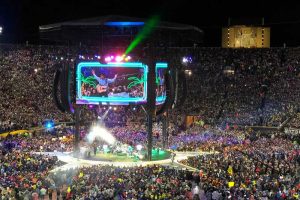Garth Brooks Tour Underscores Sports Venues’ Need for High-Quality Installed Sound
The country superstar performed at pro and college football stadiums around the U.S.
Story Highlights
Oct. 20, 2018, was a pivotal date for Garth Brooks, the best-selling music artist in U.S. history. That day in South Bend, IN, he performed in front of 84,000 fans, the first concert ever produced at Notre Dame’s football stadium. It was also the template for Brooks’s next move: after a three-year tour of arena venues during which he sold more than 6.3 million tickets, he was scheduled to embark on another 36-month tour, this time of NFL and college-football stadiums in the U.S.

Country-music star Garth Brooks performed 84,000 fans in the first concert ever at Notre Dame’s football stadium.
This next tour of even larger venues, which began March 9 in St. Louis, at The Dome at America’s Center, comes as sports venues in general and stadiums in particular have been realizing that their installed sound systems and acoustical treatments need significant upgrades in an era when successful concerts will be necessary for those venues’ economics to remain viable. An artist of Brooks’s stature and his documented willingness to go the extra yard for the sonic quality of his live shows made the tour a spotlight on stadium sound.
“Notre Dame was the prototype for stadium tours,” says Josh Sadd, VP/chief engineer, Clair Brothers, Brooks’s longtime sound-reinforcement vendor on tours. Sadd, who designs and tunes Brooks’s touring systems, says his stadium-system design grew out of a two-night engagement at Yankee Stadium in 2016. For the Notre Dame show, the stage was placed at the 50-yard line; for subsequent gridiron venues, the stage was moved toward one end of the field but with room left for seating behind it.
The Venues’ Systems
A characteristic of this tour and of most others that will be visiting stadiums in the future is the interface between the touring system and the venues’ installed-sound systems. Interaction has been rare but is increasingly common, comprehensively covering upper-deck seating. In Brooks’s case, the core of the touring rig is the Clair Brothers i218 line-array system, which at the Notre Dame concert used a total of 96 i218 array cabinets and 48 i212 cabinets in the main array hangs, all eight hangs featuring identical equipment.
In many cases, the tour will use some of the venue’s upper-deck sound-system components. In that case, says Sadd, the tour’s sound team will spend significant time with the house systems and its engineers, looking to critically align the touring and the installed components — speakers, amplifiers, DSP — into a single coherent system to the extent possible. He notes the additional time taken to align the touring system with the upper-deck JBL/Harman Pro speakers, amplifiers, and DSP at the Pittsburgh Steelers’ Heinz Field for the May 18 show.
Acoustical tempering, however, is harder to achieve, because of wide variations in stadium geometries, particularly in their upper reaches. Sadd points out that some college venues have raked seating in a straight line from bottom to top, making acoustical modeling very predictable, and other stadiums have balconies and suites that intrude into the soundfield. The height of the highest seats also varies considerably from venue to venue, with NFL stadiums overshadowing the NCAA venues but with newer college stadiums starting to catch up.
Tough Room
What makes the Brooks tour different, however, is that it rarely plays a show the same day it loads in, providing more time for coordinating with the venue’s systems and their operators. That was especially important for certain venues, such as the U.S. Bank Stadium in Minneapolis, which has been notorious for sound issues since it opened in 2016 and through a series of concerts by U2, Kenny Chesney, and Ed Sheeran. The venue’s live sound has been panned by professionals and consumers alike.
“At U.S. Bank, we actually went out well ahead of the show to check it out,” says Sadd. “For some venues, getting the CAD [drawings] and consulting with the engineering people at the venue might be enough, but, for others, we have to be onsite well ahead of time. It usually takes between four and eight hours just to get that interface done, to decide which amp zones to use, and then to get them all properly time-aligned.”
U.S. Bank also required Brooks’s engineers to provide some acoustical treatment, mainly to cover certain key reflective surfaces, such as scoreboards, and to take the care to aim nearby speakers away from other reflective surfaces.
Dan Heins, Brooks’s longtime front-of-house mixer, acknowledges that most tours won’t have the same kind of time and latitude to interact with stadiums ahead of time and that, even though stadiums need to accommodate more types of entertainment than ever, they’re still designed with sports as their primary mission.
“Music isn’t their number-one priority, and we know that,” he says. “So a tour like ours is definitely raising awareness about the need for quality sound and what it takes to achieve that. That’s also being communicated by the system consultants, like WJHW. Stadium sound is getting better, but it will take a lot of work.”
